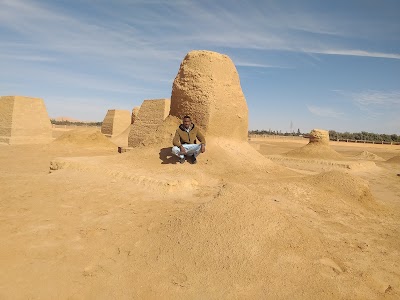Messak Settafet Plateau (هضبة مساك سيتافت)
Overview
The Messak Mellet, also known as the Messak Settafet Plateau, is an extraordinary archaeological site nestled in the Wadi al Hayaa District of Libya. This plateau is not merely a stretch of land; it is a treasure trove of ancient human history and creativity, offering a glimpse into how early humans interacted with their environment.
Situated deep within the Sahara Desert, the Messak Mellet is a vast expanse of sandstone that rises majestically above the desert floor. Spanning hundreds of kilometers, this plateau stands as a testament to the breathtaking beauty and harshness of the desert landscape. Its rugged terrain, featuring rocky outcrops and dramatic escarpments, has been sculpted by millions of years of weathering and erosion, creating a striking backdrop for exploration.
What truly sets the Messak Mellet apart is the stunning array of prehistoric rock art that embellishes its surfaces. These petroglyphs, carved and etched into the sandstone thousands of years ago, serve as invaluable windows into the lives of ancient peoples. The artwork predominantly features engravings of animals, human figures, and abstract patterns. Visitors can observe depictions of giraffes, elephants, and other species that once roamed the region when it was a greener, more hospitable environment.
The creation of these petroglyphs required rudimentary yet effective tools and techniques. Early humans skillfully used harder stones to chip away at the softer sandstone, gradually crafting intricate designs and images. This labor-intensive process demanded a deep understanding of the material and considerable craftsmanship. The presence of such art implies that the Messak Mellet was not just a canvas but also a significant cultural and spiritual site for prehistoric communities.
In addition to the remarkable rock art, the plateau reveals signs of ancient habitation. Archaeologists have unearthed stone tools, including hand axes and arrowheads, dating back to the Middle Stone Age. These artifacts suggest that the plateau was more than just an artistic outlet; it served as a shelter and resource-rich area for early humans. The evidence indicates that its inhabitants were hunter-gatherers who adeptly utilized the natural resources of the plateau to sustain their way of life.
The importance of the Messak Mellet extends beyond its archaeological treasures; it also holds geological significance. The sandstone formations provide crucial insights into the region’s geological history, offering clues about ancient climatic conditions and environmental changes. Researchers studying the strata of the plateau can trace shifts in climate and how these alterations influenced the flora and fauna of the area over millennia.
Today, the Messak Mellet is a protected site, recognized for its historical and cultural significance. Initiatives have been undertaken to preserve the delicate rock art and safeguard the area from potential damage or vandalism. However, its remote location makes the plateau relatively inaccessible, which has played a role in maintaining its pristine condition.
Visitors to the Messak Mellet can experience a profound connection to the ancient past. The isolation and stark beauty of the plateau create an atmosphere of timelessness, where one can almost hear the echoes of long-gone artists and inhabitants. The combination of natural splendor, archaeological significance, and historical mystery makes the Messak Mellet a truly unique and awe-inspiring destination for travelers seeking to explore the rich tapestry of human history.







